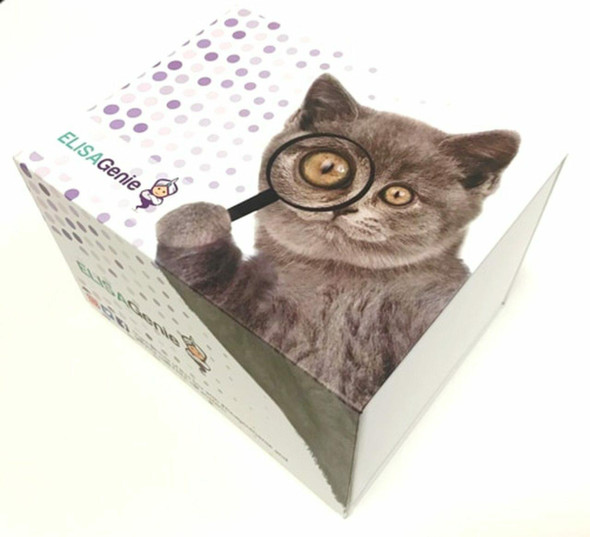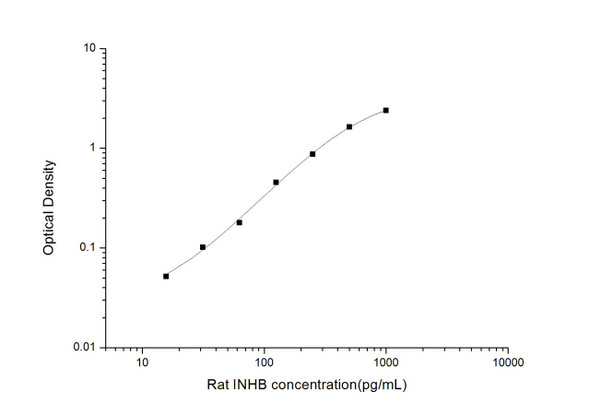Mouse INHB (Inhibin B) ELISA Kit (MOES01195)
- SKU:
- MOES01195
- Product Type:
- ELISA Kit
- Size:
- 96 Assays
- Uniprot:
- Q04997(INHA)&Q04999(INHBB
- Sensitivity:
- 9.38pg/mL
- Range:
- 15.63-1000pg/mL
- ELISA Type:
- Sandwich
- Synonyms:
- INH-B
- Reactivity:
- Mouse
- Sample Type:
- Serum, plasma and other biological fluids
Description
Mouse INHB (Inhibin B) ELISA Kit
The Mouse INHB (Inhibin-B) ELISA Kit is specifically designed for the precise measurement of inhibin-B levels in mouse serum, plasma, and tissue culture supernatants. This kit offers exceptional sensitivity and specificity, guaranteeing consistent and accurate results for various research purposes.Inhibin-B is a key protein that plays a vital role in regulating the reproductive system, particularly in the synthesis and secretion of follicle-stimulating hormone (FSH) from the pituitary gland.
Abnormal levels of inhibin-B have been linked to disorders such as infertility, polycystic ovarian syndrome (PCOS), and ovarian cancer, making it a valuable biomarker for investigating these conditions and developing potential treatments.With its advanced technology and reliable performance, the Mouse INHB (Inhibin-B) ELISA Kit is an essential tool for researchers studying reproductive biology and related disorders in mouse models.
| Assay type: | Sandwich |
| Format: | 96T |
| Assay time: | 4.5h |
| Reactivity: | Mouse |
| Detection Method: | Colormetric |
| Detection Range: | 15.63-1000 pg/mL |
| Sensitivity: | 9.38 pg/mL |
| Sample Volume Required Per Well: | 100µL |
| Sample Type: | Serum, plasma and other biological fluids |
| Specificity: | This kit recognizes Mouse INHB in samples. No significant cross-reactivity or interference between Mouse INHB and analogues was observed. |
This ELISA kit uses Sandwich-ELISA as the method. The micro ELISA plate provided in this kit has been pre-coated with an antibody specific to Mouse INHB. Standards or samples are added to the appropriate micro ELISA plate wells and combined with the specific antibody. Then a biotinylated detection antibody specific for Mouse INHB and Avidin-Horseradish Peroxidase (HRP) conjugate are added to each micro plate well successively and incubated. Free components are washed away. The substrate solution is added to each well. Only those wells that contain Mouse INHB, biotinylated detection antibody and Avidin-HRP conjugate will appear blue in color. The enzyme-substrate reaction is terminated by adding Stop Solution and the color turns yellow. The optical density (OD) is measured spectrophotometrically at a wavelength of 450 nm ± 2 nm. The OD value is proportional to the concentration of Mouse INHB. The concentration of Mouse INHB in samples can be calculated by comparing the OD of the samples to the standard curve.
| UniProt Protein Function: | INHBA: Inhibins and activins inhibit and activate, respectively, the secretion of follitropin by the pituitary gland. Inhibins/activins are involved in regulating a number of diverse functions such as hypothalamic and pituitary hormone secretion, gonadal hormone secretion, germ cell development and maturation, erythroid differentiation, insulin secretion, nerve cell survival, embryonic axial development or bone growth, depending on their subunit composition. Inhibins appear to oppose the functions of activins. Belongs to the TGF-beta family. |
| UniProt Protein Details: | Protein type:Secreted; Secreted, signal peptide Cellular Component: extracellular space; cell; extracellular region Molecular Function:identical protein binding; growth factor activity; protein heterodimerization activity; peptide hormone binding; hormone activity; cytokine activity; transforming growth factor beta receptor binding; receptor binding Biological Process: positive regulation of transcription, DNA-dependent; positive regulation of cellular protein metabolic process; activin receptor signaling pathway; mesodermal cell differentiation; palate development; negative regulation of cell cycle; regulation of apoptosis; odontogenesis; negative regulation of cell proliferation; ovarian follicle development; hair follicle development; cell cycle arrest; hemoglobin biosynthetic process; response to drug; regulation of follicle-stimulating hormone secretion; positive regulation of erythrocyte differentiation; male gonad development; negative regulation of hair follicle development; progesterone secretion; regulation of transcription from RNA polymerase II promoter; mesoderm formation; regulation of MAPKKK cascade; positive regulation of transcription from RNA polymerase II promoter; hemopoietic progenitor cell differentiation; negative regulation of cell growth; cell development; G1/S transition of mitotic cell cycle; growth |
| UniProt Code: | Q04998 |
| NCBI GenInfo Identifier: | 462406 |
| NCBI Gene ID: | 16323 |
| NCBI Accession: | Q04998. 1 |
| UniProt Related Accession: | Q04998 |
| Molecular Weight: | 47,392 Da |
| NCBI Full Name: | Inhibin beta A chain |
| NCBI Synonym Full Names: | inhibin beta-A |
| NCBI Official Symbol: | Inhba |
| NCBI Protein Information: | inhibin beta A chain; activin beta-A chain |
| UniProt Protein Name: | Inhibin beta A chain |
| UniProt Synonym Protein Names: | Activin beta-A chain |
| Protein Family: | Inhibin |
| UniProt Gene Name: | Inhba |
| UniProt Entry Name: | INHBA_MOUSE |
As the OD values of the standard curve may vary according to the conditions of the actual assay performance (e. g. operator, pipetting technique, washing technique or temperature effects), the operator should establish a standard curve for each test. Typical standard curve and data is provided below for reference only.
| Concentration (pg/mL) | O.D | Average | Corrected |
| 1000 | 2.451 2.477 | 2.464 | 2.38 |
| 500 | 1.671 1.675 | 1.673 | 1.589 |
| 250 | 0.975 0.957 | 0.966 | 0.882 |
| 125 | 0.456 0.464 | 0.46 | 0.376 |
| 62.5 | 0.274 0.274 | 0.274 | 0.19 |
| 31.25 | 0.19 0.18 | 0.185 | 0.101 |
| 15.63 | 0.129 0.143 | 0.136 | 0.052 |
| 0 | 0.074 0.094 | 0.084 | -- |
Precision
Intra-assay Precision (Precision within an assay): 3 samples with low, mid range and high level Mouse INHB were tested 20 times on one plate, respectively.
Inter-assay Precision (Precision between assays): 3 samples with low, mid range and high level Mouse INHB were tested on 3 different plates, 20 replicates in each plate.
| Intra-assay Precision | Inter-assay Precision | |||||
| Sample | 1 | 2 | 3 | 1 | 2 | 3 |
| n | 20 | 20 | 20 | 20 | 20 | 20 |
| Mean (pg/mL) | 53.03 | 116.10 | 368.86 | 53.27 | 112.96 | 397.25 |
| Standard deviation | 3.40 | 6.83 | 13.83 | 3.39 | 5.34 | 16.61 |
| C V (%) | 6.41 | 5.88 | 3.75 | 6.36 | 4.73 | 4.18 |
Recovery
The recovery of Mouse INHB spiked at three different levels in samples throughout the range of the assay was evaluated in various matrices.
| Sample Type | Range (%) | Average Recovery (%) |
| Serum (n=5) | 95-105 | 100 |
| EDTA plasma (n=5) | 86-98 | 93 |
| Cell culture media (n=5) | 92-107 | 98 |
Linearity
Samples were spiked with high concentrations of Mouse INHB and diluted with Reference Standard & Sample Diluent to produce samples with values within the range of the assay.
| Serum (n=5) | EDTA plasma (n=5) | Cell culture media (n=5) | ||
| 1:2 | Range (%) | 87-102 | 92-106 | 92-106 |
| Average (%) | 93 | 98 | 99 | |
| 1:4 | Range (%) | 92-104 | 82-93 | 85-101 |
| Average (%) | 97 | 88 | 92 | |
| 1:8 | Range (%) | 89-103 | 80-92 | 81-92 |
| Average (%) | 95 | 87 | 87 | |
| 1:16 | Range (%) | 93-106 | 81-95 | 84-97 |
| Average (%) | 99 | 88 | 89 |
An unopened kit can be stored at 4°C for 1 month. If the kit is not used within 1 month, store the items separately according to the following conditions once the kit is received.
| Item | Specifications | Storage |
| Micro ELISA Plate(Dismountable) | 8 wells ×12 strips | -20°C, 6 months |
| Reference Standard | 2 vials | |
| Concentrated Biotinylated Detection Ab (100×) | 1 vial, 120 µL | |
| Concentrated HRP Conjugate (100×) | 1 vial, 120 µL | -20°C(shading light), 6 months |
| Reference Standard & Sample Diluent | 1 vial, 20 mL | 4°C, 6 months |
| Biotinylated Detection Ab Diluent | 1 vial, 14 mL | |
| HRP Conjugate Diluent | 1 vial, 14 mL | |
| Concentrated Wash Buffer (25×) | 1 vial, 30 mL | |
| Substrate Reagent | 1 vial, 10 mL | 4°C(shading light) |
| Stop Solution | 1 vial, 10 mL | 4°C |
| Plate Sealer | 5 pieces | |
| Product Description | 1 copy | |
| Certificate of Analysis | 1 copy |
- Set standard, test sample and control (zero) wells on the pre-coated plate and record theirpositions. It is recommended to measure each standard and sample in duplicate. Note: addall solutions to the bottom of the plate wells while avoiding contact with the well walls. Ensuresolutions do not foam when adding to the wells.
- Aliquot 100µl of standard solutions into the standard wells.
- Add 100µl of Sample / Standard dilution buffer into the control (zero) well.
- Add 100µl of properly diluted sample (serum, plasma, tissue homogenates and otherbiological fluids) into test sample wells.
- Cover the plate with the sealer provided in the kit and incubate for 90 min at 37°C.
- Aspirate the liquid from each well, do not wash. Immediately add 100µL of BiotinylatedDetection Ab working solution to each well. Cover the plate with a plate seal and gently mix. Incubate for 1 hour at 37°C.
- Aspirate or decant the solution from the plate and add 350µL of wash buffer to each welland incubate for 1-2 minutes at room temperature. Aspirate the solution from each well andclap the plate on absorbent filter paper to dry. Repeat this process 3 times. Note: a microplatewasher can be used in this step and other wash steps.
- Add 100µL of HRP Conjugate working solution to each well. Cover with a plate seal andincubate for 30 min at 37°C.
- Aspirate or decant the solution from each well. Repeat the wash process for five times asconducted in step 7.
- Add 90µL of Substrate Reagent to each well. Cover with a new plate seal and incubate forapproximately 15 min at 37°C. Protect the plate from light. Note: the reaction time can beshortened or extended according to the actual color change, but not by more than 30min.
- Add 50 µL of Stop Solution to each well. Note: Adding the stop solution should be done inthe same order as the substrate solution.
- Determine the optical density (OD value) of each well immediately with a microplate readerset at 450 nm.







